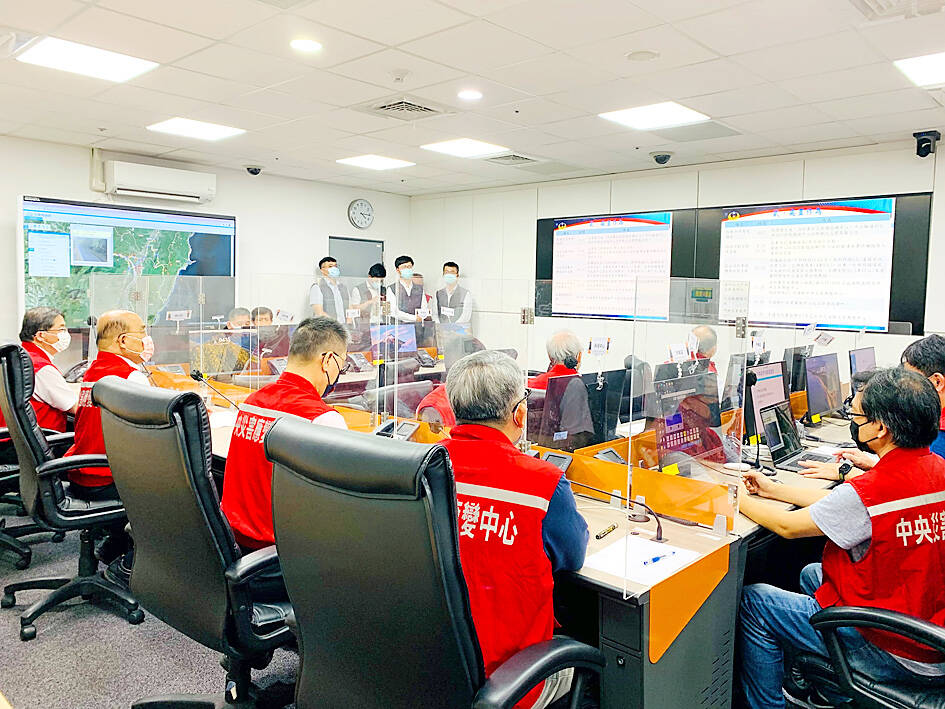People should be prepared for further damage caused by aftershocks following a magnitude 6.8 earthquake at 2:44pm yesterday, although its aftershocks are expected to be of smaller magnitude and occur less frequently than yesterday’s quakes, the Central Weather Bureau (CWB) said yesterday.
Bureau data showed that the quake’s epicenter was 42.7km north of Taitung County Hall at a depth of 7km, which is within Taitung’s Chihshang Township (池上).
The magnitude 6.8 quake, the strongest recorded this year, occurred as the nation was recovering from damage caused by a magnitude 6.4 temblor on Saturday night, with its epicenter in Guanshan Township (關山).

Photo provided by the Executive Yuan
That quake was one of the 73 foreshocks of yesterday’s earthquake, CWB Seismological Center Director Chen Kuo-chang (陳國昌) told reporters.
Yesterday’s quake is also the eighth with a magnitude exceeding 6 this year, Chen said, adding that it could be ranked the sixth or seventh-largest earthquake in Taiwan’s seismic history, following the 921 Earthquake in 1999 and the large aftershocks that followed.
Although few earthquakes have occurred in the past 50 years near the epicenters of this weekend’s quakes, they originated from the inner part of where the Philippine Sea Plate and the Eurasian Plate touch, Chen said.
Compared with the outer side, which is off the coast of Taitung’s Chenggong Township (成功), the inner side has a more rigid rock formation, where earthquakes happen less frequently, he said.
The seismic energy that has accumulated on the inner side of the plates’ meeting point over the past five decades was first released through the magnitude 6.4 earthquake on Saturday, which has likely been balanced by the main earthquake yesterday.
“We cannot predict the occurrences of earthquakes. Theoretically, however, the aftershocks should be of smaller magnitude compared to that of the main earthquake. I estimate that aftershocks are not likely to occur as frequently as the foreshocks. The number of aftershocks exceeding magnitude 5 will also be fewer than the foreshocks,” Chen said.
An aftershock of magnitude 5.4 occurred shortly after yesterday’s earthquake, he added.
A similar situation occurred in 2018, when a magnitude 6.32 earthquake on the Milun Fault triggered an aftershock of magnitude 5.92, he said.
“The Milun Fault is a geologically fragmented zone, and the seismic activities on the zone generated activities in other geological zones from the north to south, as well as from land to sea. The aftershocks lasted about a month, with the number reaching 30 per hour, or three to four per day,” he said, adding that the frequency of aftershocks from this weekend’s quake would not reach that number.
The public warning system for natural disasters functioned normally yesterday, with residents in eight cities and counties south of Chiayi County receiving warnings 10 seconds before the main earthquake, Chen said.
President Tsai Ing-wen (蔡英文) urged people to be vigilant for further aftershocks in the coming hours.
“Water and electricity supplies in some areas have also been affected by the earthquake,” she wrote on Facebook. “The related disaster relief work is in full swing.”
Additional reporting by AFP

The brilliant blue waters, thick foliage and bucolic atmosphere on this seemingly idyllic archipelago deep in the Pacific Ocean belie the key role it now plays in a titanic geopolitical struggle. Palau is again on the front line as China, and the US and its allies prepare their forces in an intensifying contest for control over the Asia-Pacific region. The democratic nation of just 17,000 people hosts US-controlled airstrips and soon-to-be-completed radar installations that the US military describes as “critical” to monitoring vast swathes of water and airspace. It is also a key piece of the second island chain, a string of

A magnitude 5.9 earthquake that struck about 33km off the coast of Hualien City was the "main shock" in a series of quakes in the area, with aftershocks expected over the next three days, the Central Weather Administration (CWA) said yesterday. Prior to the magnitude 5.9 quake shaking most of Taiwan at 6:53pm yesterday, six other earthquakes stronger than a magnitude of 4, starting with a magnitude 5.5 quake at 6:09pm, occurred in the area. CWA Seismological Center Director Wu Chien-fu (吳健富) confirmed that the quakes were all part of the same series and that the magnitude 5.5 temblor was

The Central Weather Administration has issued a heat alert for southeastern Taiwan, warning of temperatures as high as 36°C today, while alerting some coastal areas of strong winds later in the day. Kaohsiung’s Neimen District (內門) and Pingtung County’s Neipu Township (內埔) are under an orange heat alert, which warns of temperatures as high as 36°C for three consecutive days, the CWA said, citing southwest winds. The heat would also extend to Tainan’s Nansi (楠西) and Yujing (玉井) districts, as well as Pingtung’s Gaoshu (高樹), Yanpu (鹽埔) and Majia (瑪家) townships, it said, forecasting highs of up to 36°C in those areas

IN FULL SWING: Recall drives against lawmakers in Hualien, Taoyuan and Hsinchu have reached the second-stage threshold, the campaigners said Campaigners in a recall petition against Chinese Nationalist Party (KMT) Legislator Yen Kuan-heng (顏寬恒) in Taichung yesterday said their signature target is within sight, and that they need a big push to collect about 500 more signatures from locals to reach the second-stage threshold. Recall campaigns against KMT lawmakers Johnny Chiang (江啟臣), Yang Chiung-ying (楊瓊瓔) and Lo Ting-wei (羅廷瑋) are also close to the 10 percent threshold, and campaigners are mounting a final push this week. They need about 800 signatures against Chiang and about 2,000 against Yang. Campaigners seeking to recall Lo said they had reached the threshold figure over the